Excitation out of the ground state
Monochromator / Absolute Calibration System

What are all the different types of Cross Sections?
Consider an atom with a number of excited states. A collision between an electron (e-) and an atom can excite the atom to any of these excited states; say, to level-i. The atom can then decay from level-i to any number of lower levels j, k... The probability that an atom will be excited to level-i and decay to level-k is described in terms of the optical cross section Qi-j. If we sum together all the optical cross sections for atoms decaying out of state-i we find the apparrent cross section Qi.See the overview for more on the different type of cross sections.
How do we measure the signal?
In this experiment, a variable-energy electron beam passes through a vacuum chamber that has been filled with a few mTorr of gas. The electron beam excites the atoms into higher levels, and when these levels decay, they emit light. This emitted radiation is wavelength selected by a 1.26m monchromator, and is measured with a photomultiplier tube. A computer reads the target gas pressure (measured by a baratron), the electron current, and the PMT signal. From this information we can extract optical cross sections.
Absolute calibration of cross sections:
To place the results on an absolute scale, we must know exactly how many photons are collected by the PMT. That is, we must know the detection efficiency of the optical system. To do this, we rotate mirror M1 to face a standard lamp of known irradiance.Some experimental specs:
| Target Density: | 1011 to 1014 atom/cm3 (10-5 to 10-2 Torr) |
| Energy Range: | 0 to 1000 eV |
| Electron Beam current: | 150 µA at 100 eV |
| Gases studied: | Helium, Neon, Argon, Krypton, Xenon, Nitrogen |
Recent Published Results
- Angular momentum coupling and electron-impact excitation cross sections of rare-gas atoms
-
Tobin Weber, John B. Boffard, and Chun C. Lin,
Int. J. Mass Spectrom. 233, (2004) 75.
- Electron-impact excitation cross sections of the higher argon 3p5np, (n=5,6,7) levels
-
Tobin Weber, John B. Boffard, and Chun C. Lin,
Physical Rev. A 68, (2003) 032719.
- Excitation transfer cross sections for levels of the Ne 2p53d configuration
-
John B. Boffard, M. D. Stewart Jr., and Chun C. Lin,
Physical Rev.A 65, (2002) 062701.
- Use of radiation trapping for measuring electron-impact excitation cross sections for higher resonance levels of rare-gas atoms
-
M. D. Stewart, Jr., J. Ethan Chilton, John B. Boffard, and Chun C. Lin ,
Phys Rev. A 65 (2002) 032704.
- Electron-impact excitation of the second positive band system (C 3IIu -> B 3IIg) and the C 3IIu electronic state of the nitrogen molecule
-
John T. Fons , R. Scott Schappe, and Chun C. Lin,
Physical Review A 53 (1996) 2239-2247.
- Production of electronically excited N2+ ions by electron impact on N2 molecules
-
John T. Fons, James S. Allen, R. Scott Schappe, and Chun C. Lin,
Physical Review A 49 (1994) 927-932.
back to experiments list... back to home page